The Fact Sheet Fusion Interface

Components of a fact sheet
A fact sheet is usually comprised of headings, text and multimedia. Fact Sheet Fusion is designed to create standardized fact sheets; by this we mean that each fact sheet has a similar look and feel in its design and each fact sheet is built using a common set (or subset) of topic headings.To develop a Fact Sheet Fusion project a list of topic headings is entered along with a list of entities*. For each entity, text is entered for each topic heading, and these topic headings, along with corresponding text, are integrated for each entity when being transformed into the final fact sheet.
* An entity is the object for which the fact sheet is being created. An entity can be anything such as an insect, fish or plant species, a medical disorder, or any other series of objects that are described according to specific topics.
To make a fact sheet more informative images, and other media (videos, sounds, PDF, Office documents) can be linked to entities. These images are then included with the text at the time of fact sheet creation.
The presentation and structure of a fact sheet is determined by the specific template the user selects. The template dictates every aspect of the fact sheet such as the layout, color scheme, the positioning of topics and images, font sizes etc.
See Templates help topic for further information.
Main Toolbar
 Preview
Preview
The preview button automatically exports the selected entity as
a fact sheet using the current export settings. Once the export
has completed, the fact sheet will be loaded into the default
web browser or PDF reader (depending on the export output type).
If the minimum export settings have not yet been entered the
export dialog will be automatically opened. The export settings
then need to be adjusted before the preview can be completed.
 Export
Export
The Export button will open the Export dialog allowing
you to adjust the various export settings and perform a full
export your fact sheets. See the Export help topic for
further information on exporting fact sheets. Glossary Manager
Glossary Manager
The Glossary Manager button opens the Glossary Manager dialog
allowing you to enter glossary sets, terms and definitions for
your fact sheets. See the Glossary Manager help topic for further information. Media
Manager
Media
Manager
The Media Manager button will open the Media Manager dialog where
you can add, edit and remove media associated with the fact
sheets. See the Media Manager
help topic for further information. Image
Watermark Manager
Image
Watermark Manager
The Image Watermark Manager button opens the Image Watermark
Manager dialog where you can manage the image watermarks and their
default settings for your project. See the Image Watermark Manager
help topic for further information.Menus
File Menu

The file menu allows you to open a different Project (Ctrl+P) within the currently opened Fusion database, open a different Fusion Database (Ctrl+O) containing other projects, or to Import content from HTML or MS Word files.
Edit Menu
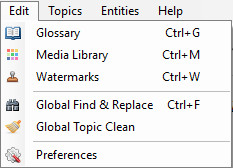
The edit menu gives you access to the Glossary (Ctrl+G), Media Library (Ctrl+M), Watermarks (Ctrl+W), Global Find & Replace (Ctrl+F), Global Topic Clean and Preferences.
Topics Menu
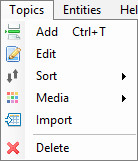
The Topic menu gives you access to actions available for managing Topics. Menu items will only be available if they are able to perform the action. For example, the Delete option would be unavailable if no topics are present. For more information on Topics please see the Topics help section below.
Entities Menu
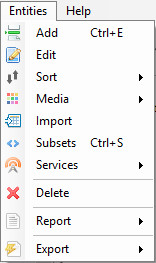
The Entities menu gives you access to actions available for managing Entities. Menu items will only be available if they are able to perform the action. For example, the Delete option would be unavailable if no entities are present. For more information on Entities please see the Entities help section below.
Help Menu

The help menu gives access to this help file and to the about dialog, where version information and the log file is accessible. You can also check for updates to Fact Sheet Fusion that may have become available.
Topics
Topics within Fact Sheet Fusion are generic headings for the Fact Sheets. The topic text is then displayed for the respective Topic heading. If a Topic for a given entity contains no topic text then the topic will be excluded from the fact sheet. It is also possible to include the topic text, without the Topic being present as a heading. Adding Topics
Adding Topics
To add a new topic to the Topic list, first give focus to the
Topic list by clicking on it. You can tell when the Topic has
focus as its background will change color. Adding a new Topic can
be done in several ways.
1. Via the Topic Menu...Add (Ctrl + T)
2. Via the pop-up context menu accessible by right clicking within the Topic list.
3. Via the Import (Ins) option (available via the Topic menu or the context menu).
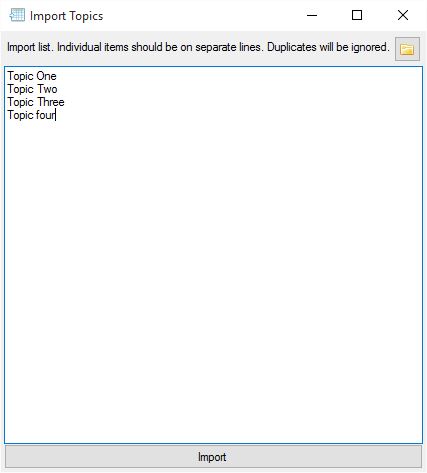
 Editing Topics
Editing Topics
To edit an existing topic, select that topic by clicking on it (or
use the up or down arrow keys to navigate to it). Then you can
select the edit option (via the Topic menu or context menu), or
simply press Ctrl + E. Make the desired changes and click the update
button to complete the task.
 Deleting Topics
Deleting Topics
To delete a topic, first select it by clicking on it (or use the
up or down arrow keys to navigate to it). Then select the delete
option from the Topic menu or context menu, or simply press the
delete key. You will need to confirm that you wish to delete the
topic.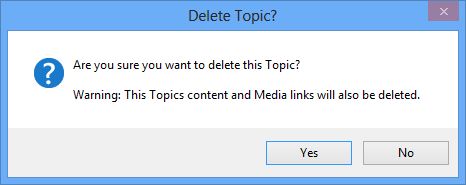
Deleting a Topic will also automatically remove all text and media references (but it will not delete the media files) from the Topic.
Note: There is no undo for this action.

 Sorting Topics
Sorting Topics
You can sort topics in two ways. You can either sort all the
topics automatically in to ascending or descending order via the
Topic Sort sub menu or context menu. Alternatively, you can
manually sort the Topics using Drag and Drop.Topic Properties
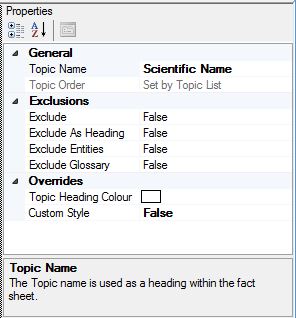
When you give focus to a Topic its properties will be listed within the Properties section of the interface located top right. When you give focus to a Topic property you will see a small help topic listed at the bottom of the properties describing its function.
General
Topic Name - You can edit the Topic name via the properties or as described above.
Topic Order - This is set by the Topic list and is a read only property.
Exclusions
Exclude - You can exclude the topic from the export process by setting this property to true.
Exclude as Heading - The Topic name will be excluded as a heading though the topics text will still be output within the fact sheet.
Exclude Entities - Exclude cross-linking of any entities found within the text of this Topic during the export process.
Exclude Glossary - Exclude the cross-linking of glossary terms found with in the text of this topic during the export process.
Overrides
Topic Heading Color - Normally the export template will define the color (and style) of the Topic headings within the fact sheet. However you can override this with your preferred color. This color will be applied to this topic heading in all fact sheets that it appears.

Custom Style - Normally the export template will define the style and formatting of the topic heading. However you can completely override the export templates style sheet by defining your own in-line styles.
The styles defined should follow the same rules for applying an HTML in-line style. E.g. An in-line style on a heading tag:
<h1 style="color:#333;text-transform:uppercase;border:none;">My Topic</h1>
The Custom Style should only define the style definitions, not the tags. i.e. The highlighted section below from the example above:
<h1 style="color:#333;text-transform:uppercase;border:none;">My Topic</h1>
Entities
 Adding Entities
Adding Entities
To add a new Entity to the Entity list, first give focus to the
Entity list by clicking on it. You can tell when the Entity has
focus as its background will change color. Adding a new Entity can
be done in several ways:
1. Via the Entities Menu...Add (Ctrl + E)
2. Via the pop-up context menu accessible by right clicking within the Entity list.
3. Via the Import (Ins) option (available via the Entities menu or the context menu). You can also elect to add the entities to an existing or new Subset automatically. To do this either select an existing Subset from the dropdown menu or type in the name of a new Subset.
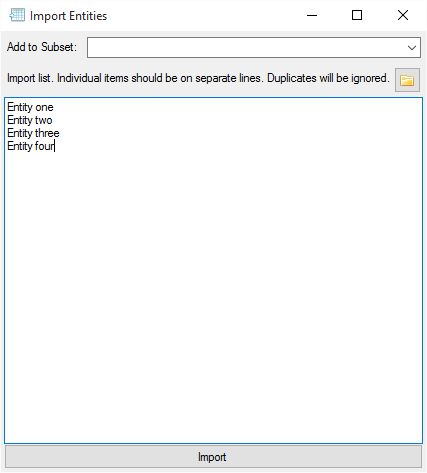
Note: When an entity is created a corresponding Media Category of the same name will also be created, if it doesn't exist.
 Editing Entities
Editing Entities
To edit an existing entity select the entity by clicking on it (or
use the up or down arrow keys to navigate to it). Then you can
select the edit option (via the Entities menu or context menu), or
simply press Ctrl+E. Make the desired changes and click the update
button to complete the task.
Note: When an entity is renamed, it's corresponding Media Category will also be renamed.
 Deleting
Entities
Deleting
Entities
To delete an Entity, first select it by clicking on it (or use
the up or down arrow keys to navigate to it). Then select the
delete option from the Entities menu or context menu, or simply
press the delete key. You will need to confirm that you wish to
delete the Entity.
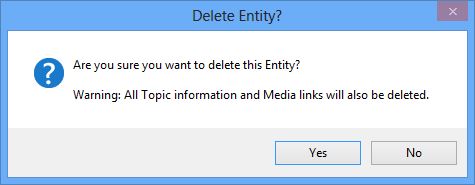
Deleting a Entity will also automatically remove all Topic text
and media references (but will not delete the media files) from
the Entity.

 Sorting Entities
Sorting Entities
By default Fact Sheet Fusion will list the Entities in the order
you enter them. However you can sort Entities in two ways. You can
either sort all the Entities automatically in to ascending or
descending order via the Entities Sort sub menu or context menu.
Or you can manually sort the Entities using Drag and Drop.Entity Properties
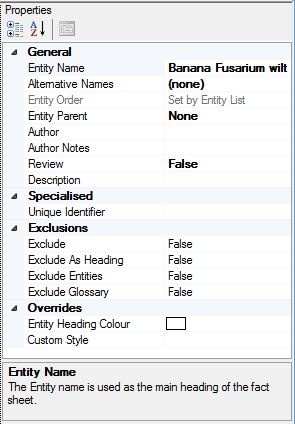
When you give focus to an Entity its properties will be listed within the Properties section of the interface located top right. When you give focus to an Entity property you will get a small help topic listed at the bottom of the properties describing its function.
General
Entity Name - You can edit the Entity name in the properties panel or as described above.
Alternative Names - This property allows you to assign alternative names associated with the Entity. For example, common names, synonyms etc. See the Alternative Names help topic for further information.
Entity Order - The sort order of the entities is controlled by the Entity list. See the Sorting options for Entities above.
Entity Parent - You may select another entity as the parent of the selected entity. This can be used when grouping and listing entities, for example, within the index page.
Author - You may enter the author of the entity fact sheet here. The author information can be exported out into the fact sheet meta-data or wherever it is supported in the export template.
Author Notes - These are private notes relating to the entity. They will not be included as a part of the export process.
Review - Mark the entity as needing review. E.g. For further editing. Marking an Entity for review will give you the option of excluding the entity in the export process. See the Export Entity Options help topic for further information.
Description - The description field is a short summary of the entity fact sheet. It can be used in the Fact Sheet meta-data or wherever it is supported in the export template.
Specialized
Unique Identifier - The unique identifier is a code (number, text or combination thereof) such as an LSID or database ID that can be used where supported in specialized export templates. For example, it could be used as a part of a query string to filter or to return additional information from an online system.
Exclusions
Exclude - If set to true the entity will be excluded from the export process and no fact sheet will be created, unless overridden by Export options.
Exclude as Heading - Normally most export templates place the entity name at the top of the fact sheet to identify its content. However, if needed, you can mark the entity name to be excluded as a heading, if the export template supports this.
Exclude Entities - This property allows you to exclude the cross-linking of other entities found within the entities topics.
Exclude Glossary - This property allows you to exclude the cross-linking of glossary terms found within the entities topics.
Overrides
Entity Heading Color - Normally the export template will define the color (and style) of the Entity headings within the fact sheet. However you can override this with your preferred color.

Custom Style - Normally the export template will define the style and formatting of the Entity heading. However you can completely override the export templates style sheet by defining your own in-line styles.
The styles defined should follow the same rules for applying a HTML in-line style. e.g. An in-line style on a heading tag:
<h1 style="color:#333;text-transform:uppercase;border:none;">My Entity</h1>
The Custom Style should only define the style definitions, not the tags. i.e. The highlighted section below from the example above:
<h1 style="color:#333;text-transform:uppercase;border:none;">My Entity</h1>
Subsets
Please see Subsets for further information.Services
Please see Services for further information.Reports
Please see Reports for further information.Export
Export Fact Sheets
Please see Exporting Fact Sheets for further information. Entity Names to File
Entity Names to File
This takes the currently listed entities and saves them to a text
file. Once the file has been created you will be asked where to
save it. Entity Names to Clipboard
Entity Names to Clipboard
This takes the current listed entities and saves them to the
clipboard where you can for example paste them into another
document etc.Filtering Entities
When dealing with a large number of entities it's often useful to temporarily filter the list. You can do this via the filter option found at the top of the entity list. To access the filter options click on the dropdown list.
![]() Tip: If the
entity list is selected use the following keyboard shortcut to
access the filter option: Ctrl + spacebar.
Tip: If the
entity list is selected use the following keyboard shortcut to
access the filter option: Ctrl + spacebar.

Two filter options are available:
- Text filter: Enter search criteria (text) you wish to match
within the entity list and their alternative names, if present.
Note: If a match is made on an alternative name the associated Entity will be listed, not the alternative name. This can give the appearance the entity listed didn't match the criteria you entered in the filter. - Subset filter: Selected subset(s) will filter the entities list based on the entities contained within the subset(s).
 |
 |
| Example filter option | Filter result on the entities list |
If filter criteria and subsets have both selected they will work in conjunction with each other. That is the entities are restricted to the selected subset(s), which are in turn restricted by the filter text.
Once Filter criteria has been entered and/or subsets selected click on the filter button (or press return). This will apply the filter. If the filter dropdown is closed without selecting to filter (i.e. clicking the filter button), the filter options will not be applied.
To clear the filters remove filter criteria and un-select all subsets then click the filter button.
Media
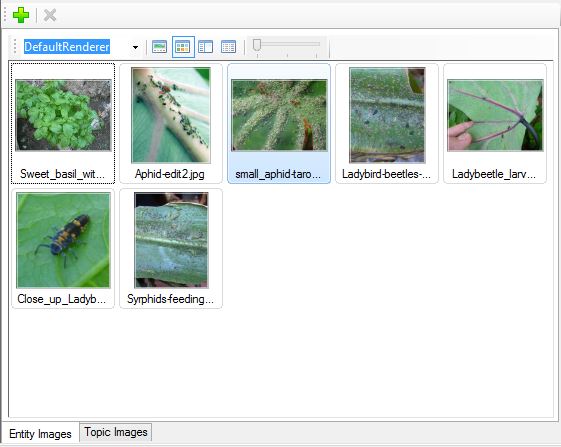
One or more media items can be linked to Entity Topics (An
Entity Topic is the combination of the selected Entity and
Topic) or directly to the Entity. Normally media that is
attached to an entities topic is shown within the section
relating to that topic in the fact sheet, while media attached
to the entity are shown either at the top or bottom of the fact
sheet. The layout of the media will vary depending on the export
template selected. You can flip between the Entity Images and
Topic Images using the tabs at the bottom of the media panel.
![]()
For more information on media please see the Media topic or the Media Manager topic.
